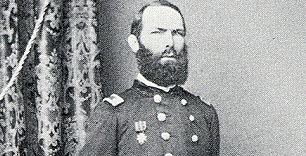Organized social justice efforts in the city of Washington began with the creation of the first conference of the Society of St. Vincent de Paul at the Church of St. Matthew the Apostle in 1859. The chapter became an official part of the international organization on the feast of the Annunciation, March 25, 1860. Richard H. Clarke was chosen as the first president of the society and Julius Peter Garesché, an Army officer who had been born in Havana, Cuba in 1821, was chosen as vice-president.
Garesché is believed to have been the motivation for the founding of the chapter and bringing the Society of St. Vincent de Paul to Washington. He had first encountered them while being stationed in St. Louis. The conference at St. Patrick’s Parish was founded in November of 1860 with Garesché chosen as its president. He resigned from the chapter at St. Matthew’s and dedicated his time to this new conference nearer to the Capitol. Garesché lived near the corner of Pennsylvania Avenue and 11th Street N.W., closer to St. Patrick’s Church.
Garesché attended Georgetown College and graduated from West Point in 1841. He spent much of his military career in the west before being posted to the Adjutant-General’s office in Washington in 1855. A biography written of Garesché by his son in 1877 describes a man who saw caring for the poor as an integral part of his life. Garesché visited poor families and provided them with needed supplies every evening after dinner. His visits to the city’s poorest residents included African Americans who were in need. He not only brought supplies of food and clothes but also assisted with nursing and medical care. Garesché also fasted regularly and attended Mass as much as his military duties allowed.

When the Civil War began, Major Garesché sought a field assignment in hopes of promotion. He was soon posted to the staff of Major General William S. Rosecrans as a lieutenant colonel and chief of staff. Rosecrans was an old friend from West Point whom Garesché is credited with helping to convert to Catholicism. Rosecrans was given command of the Army of Cumberland in late 1862.
Garesché’s first and last battle as a member of Rosecrans’ staff was at Stones River in Tennessee. As Rosecrans and his staff were riding toward the Tennessee and Chattanooga Railroad on Dec. 31, an exploding artillery shell decapitated Garesché, killing him instantly. His friends came after the battle and removed items from his body before giving him a hasty battlefield burial. His body was later reinterred at Mount Olivet Cemetery. His copy of The Imitation of Christ by Thomas a Kempis, said to be with him at the time of his death, was given by his family to Georgetown University, which also has among its collections his blood-stained scapulars.

Today if you Google his name, Julius Peter Garesché – who dedicated so much of his life to the poor residents of Washington – is identified as the headless horseman of the Stones River Battlefield.
(Dr. Jacobe serves as the director of the Archives for the Archdiocese of Washington.)











